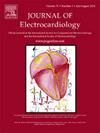心电图和超声心动图参数在评估左心房功能障碍中的相关性
IF 1.3
4区 医学
Q3 CARDIAC & CARDIOVASCULAR SYSTEMS
引用次数: 0
摘要
心电图(ECG)指标,如形态学-电压- p波(MVP)评分和超声心动图参数,如左心房容积指数(LAVi)、左心房贮液应变(LASr)和左心房附件(LAA)排空速度(LAAev)与房颤(AF)风险相关。然而,这些标记之间的关系仍然不完全清楚。目的探讨心电图MVP评分与LA大小、功能等超声心动图指标的相关性。方法在本前瞻性研究中,60例窦性心律患者,包括8例阵发性房颤患者,在30分钟内行经食管超声心动图12导联心电图和经胸超声心动图。结果二尖瓣E/ E′比值与LAVi (r = 0.30, p = 0.029)、LASr (r = - 0.42, p = 0.002)、LAAev (r = - 0.29, p = 0.037)具有显著相关性。与中高MVP评分患者相比,低MVP评分患者LAAev显著低于中高MVP评分患者(49±21 vs 61±23 cm/s, p = 0.027)。两组间LAVi(40±20 vs 42±12 ml/m2, p = 0.187)、LASr(26±11 vs 25±10%,p = 0.967)、二尖瓣E/ E′比(8.2±1.6 vs 7.3±1.3,p = 0.876)差异无统计学意义。结论lai、LASr和LAAev均与无创评估左心室充盈压相关,但只有LAAev能够根据MVP评分区分风险类别。我们的研究结果表明,与使用单个参数相比,多参数方法评估LA和LAA功能以及左室充盈压力可能提供更全面的房颤风险评估。本文章由计算机程序翻译,如有差异,请以英文原文为准。
Correlation of electrocardiographic and echocardiographic parameters in assessing left atrial dysfunction
Background
Electrocardiographic (ECG) indices, such as the morphology-voltage-P-wave (MVP) score, and echocardiographic parameters like left atrial volume index (LAVi), left atrial reservoir strain (LASr), and left atrial appendage (LAA) emptying velocity (LAAev) are associated with atrial fibrillation (AF) risk. However, the relationships between these markers remain incompletely understood.
Aims
This study aimed to investigate correlations between the ECG MVP score and echocardiographic indices of LA size and function.
Methods
In this prospective study, 60 patients in sinus rhythm, including 8 patients with paroxysmal AF, scheduled for transesophageal echocardiography underwent a 12‑lead ECG and transthoracic echocardiography within 30 min.
Results
Significant correlations were observed between the mitral E/e’ ratio and LAVi (r = 0.30, p = 0.029), LASr (r = −0.42, p = 0.002), and LAAev (r = −0.29, p = 0.037). In comparison to patients with mid-high MVP scores, LAAev was significantly lower in those with low MVP scores (49 ± 21 vs. 61 ± 23 cm/s, p = 0.027). No significant differences were observed between the groups in LAVi (40 ± 20 vs. 42 ± 12 ml/m2, p = 0.187), LASr (26 ± 11 vs. 25 ± 10 %, p = 0.967), or mitral E/e’ ratio (8.2 ± 1.6 vs. 7.3 ± 1.3, p = 0.876). Additionally, patients with paroxysmal AF had significantly lower LASr and higher mitral E/e’ ratio compared to those without paroxysmal AF.
Conclusions
While LAVi, LASr, and LAAev were all related to noninvasively assessed left ventiricular (LV) filling pressure, only LAAev was able to differentiate risk categories based on the MVP score. Our findings suggest that a multiparametric approach to evaluating LA and LAA function, and LV filling pressures may offer a more comprehensive assessment of AF risk than using individual parameters.
求助全文
通过发布文献求助,成功后即可免费获取论文全文。
去求助
来源期刊

Journal of electrocardiology
医学-心血管系统
CiteScore
2.70
自引率
7.70%
发文量
152
审稿时长
38 days
期刊介绍:
The Journal of Electrocardiology is devoted exclusively to clinical and experimental studies of the electrical activities of the heart. It seeks to contribute significantly to the accuracy of diagnosis and prognosis and the effective treatment, prevention, or delay of heart disease. Editorial contents include electrocardiography, vectorcardiography, arrhythmias, membrane action potential, cardiac pacing, monitoring defibrillation, instrumentation, drug effects, and computer applications.
 求助内容:
求助内容: 应助结果提醒方式:
应助结果提醒方式:


